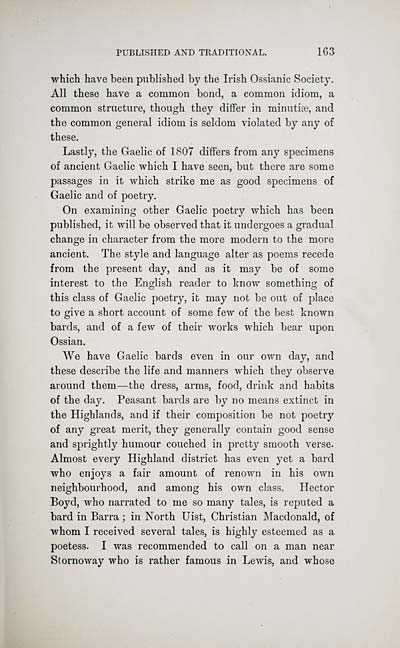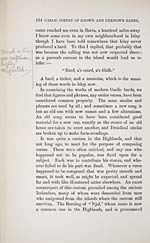Download files
Complete book:
Individual page:
Thumbnail gallery: Grid view | List view

PUBLISHED AND TRADITIONAL. 163
which have been published by the Irish Ossianic Society.
All these have a common bond, a common idiom, a
common structure, though they differ in minutiae, and
the common general idiom is seldom violated by any of
these.
Lastly, the Gaelic of 1807 differs from any specimens
of ancient Gaelic which I have seen, but there are some
passages in it which strike me as good specimens of
Gaelic and of poetry.
On examining other Gaelic poetry which has been
published, it will be observed that it undergoes a gradual
change in character from the more modern to the more
ancient. The style and language alter as poems recede
from the present day, and as it may be of some
interest to the English reader to know something of
this class of Gaelic poetry, it may not be out of place
to give a short account of some few of the best known
bards, and of a few of their works which bear upon
Ossian.
We have Gaelic bards even in our own day, and
these describe the life and manners which they observe
around them — the dress, arms, food, drink and habits
of the day. Peasant bards are by no means extinct in
the Highlands, and if their composition be not poetry
of any great merit, they generally contain good sense
and sprightly humour couched in pretty smooth verse.
Almost every Highland district has even yet a bard
who enjoys a fair amount of renown in his own
neighbourhood, and among his own class. Hector
Boyd, who narrated to me so many tales, is reputed a
bard in Barra ; in North Uist, Christian Macdonald, of
whom I received several tales, is highly esteemed as a
poetess. I was recommended to call on a man near
Stornoway who is rather famous in Lewis, and whose
which have been published by the Irish Ossianic Society.
All these have a common bond, a common idiom, a
common structure, though they differ in minutiae, and
the common general idiom is seldom violated by any of
these.
Lastly, the Gaelic of 1807 differs from any specimens
of ancient Gaelic which I have seen, but there are some
passages in it which strike me as good specimens of
Gaelic and of poetry.
On examining other Gaelic poetry which has been
published, it will be observed that it undergoes a gradual
change in character from the more modern to the more
ancient. The style and language alter as poems recede
from the present day, and as it may be of some
interest to the English reader to know something of
this class of Gaelic poetry, it may not be out of place
to give a short account of some few of the best known
bards, and of a few of their works which bear upon
Ossian.
We have Gaelic bards even in our own day, and
these describe the life and manners which they observe
around them — the dress, arms, food, drink and habits
of the day. Peasant bards are by no means extinct in
the Highlands, and if their composition be not poetry
of any great merit, they generally contain good sense
and sprightly humour couched in pretty smooth verse.
Almost every Highland district has even yet a bard
who enjoys a fair amount of renown in his own
neighbourhood, and among his own class. Hector
Boyd, who narrated to me so many tales, is reputed a
bard in Barra ; in North Uist, Christian Macdonald, of
whom I received several tales, is highly esteemed as a
poetess. I was recommended to call on a man near
Stornoway who is rather famous in Lewis, and whose
Set display mode to: Large image | Transcription
Images and transcriptions on this page, including medium image downloads, may be used under the Creative Commons Attribution 4.0 International Licence unless otherwise stated. ![]()
| Early Gaelic Book Collections > Matheson Collection > Popular tales of the west Highlands > Volume 4 > (179) |
|---|
| Permanent URL | https://digital.nls.uk/81489205 |
|---|
| Description | Volume IV. |
|---|---|
| Shelfmark | Mat.77 |
| Additional NLS resources: | |
| Attribution and copyright: |
|
| Description | Items from a collection of 170 volumes relating to Gaelic matters. Mainly philological works in the Celtic and some non-Celtic languages. Some books extensively annotated by Angus Matheson, the first Professor of Celtic at Glasgow University. |
|---|
| Description | Selected items from five 'Special and Named Printed Collections'. Includes books in Gaelic and other Celtic languages, works about the Gaels, their languages, literature, culture and history. |
|---|

